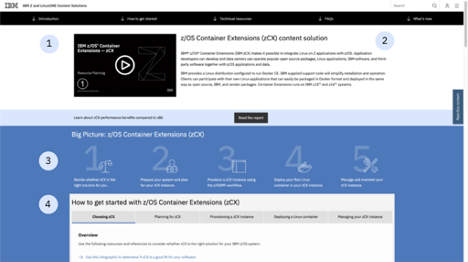
 Lindsay Baer and Kevin Bruckner, IBM
Lindsay Baer and Kevin Bruckner, IBM
June 15, 2021
Whether your content needs a simple refresh or a complete overhaul, it can be an overwhelming process to begin. Understanding where to start, what to prioritize, and how to meet the needs of your users can sometimes seem like a tall order. At IBM, our content team faced this situation as we sought to transform the technical documentation that was found in our Knowledge Center. This library housed millions of links to documentation used to run and maintain IBM Z, a powerful and complex enterprise platform used to power critical aspects of the global economy. When we realized a content transformation was needed, we knew it was essential to take our time and make sure we had a plan. What we learned through research, implementation, and iteration has helped us develop a general framework of questions that can be applied to future transformations.
Where we began
Our content transformation began when we realized our technical documentation was not fully meeting the needs of our wide range of users. For decades, our documentation was primarily text-based, with information found in books and PDFs, which became extremely technical very quickly. This approach worked for a while, but as newer users began working on the platform they sought more introductory content that was varied in presentation style and could better ease them into the complexities of the material. We began to receive feedback that information was too scattered, overly technical too quickly, and there was no clear course of action. Our team had some ideas as to what we thought they wanted instead, but to be sure, we decided to conduct a user research campaign.
Through a series of interviews and surveys with over 60 participants, our notions as to what we thought our users wanted were both validated and challenged. It was true — users were indeed looking for more introductory content, and they want to learn in a variety of ways that include video, interactive resources, and an improved user experience. Other things we thought they wanted, like chatbots, were not as aligned with their needs as we imagined.
We felt confident moving forward with the priorities because they were rooted in research, but that was only half the battle. With a Knowledge Center library of over a million links, we needed to strategy on how to implement these elements and make the most impact as quickly as possible.
Level-setting questions before beginning a content transformation
Through this process, we created a framework comprised of five level-setting questions that can help you plan your content transformation and get a handle on project needs and scope. By thoroughly answering these questions, you will create a solid foundation to base your transformation on.
1. Should this be transformed?
Before deciding to transform a piece of content, understand why you are doing so. Has it received a low Net Promoter Score (NPS), or other forms of user feedback? Has it been identified as out of date, incomplete, or incorrect? Generally speaking, what evidence indicates that this content needs to be changed?
In this instance, it is helpful to do an internal content review to understand the full picture of your existing content and identify potential gaps in information. Content audits can be used to identify all the pieces of content within a specific ecosystem and assess them in terms of importance and relevance. Content maps can help you understand the user’s journey as they make their way across your content, highlighting what content they use from start to finish. There are many ways to conduct content audits and maps, but when used together you get a clear picture of your user’s experience and identify areas that may have content gaps or roadblocks.
2. Who are you transforming this content for?
Perhaps the most important piece of all — you must understand your users! You as the content creator are not your content’s user, so you will never fully understand their experience without conducting research. Who is the audience for this material? How do you know? Do you understand what your users needs are…really?
User research will reveal much more than you can assume you know. User research can be done through interviews, surveys, user testing, and more. By doing research, you will gather insights that will inform your direction and priorities. While it’s true that doing user research can add extra time to the frontend of your project, it will surely save you time in the long run. Additionally – it will help you avoid costly mistakes by pursuing initiatives you think your users want but are actually misaligned with their needs. Our content team was really pleased we did research before committing time and resources to building a chatbot that our users actually didn’t want.
3. What new goals are you trying to achieve?
Ideally, your initial review and user research will help you identify ineffective content or missing information within your content. Once that has been determined, set new objectives to better meet your users needs. What new learning goals are you trying to achieve? What do you want this content to do that the existing content couldn’t? Decide upfront what you want to be different about this transformed content.
Live by the philosophy that “everything is a prototype.” Once you publish content, the journey doesn’t end — you should continually evaluate the content’s success towards reaching its goals. There are many ways to continue the feedback loop: user interviews, usability sessions, and Net Promoter Score (NPS) tracking are some useful tools to measure progress towards your objectives. As such, you can continually refine your content to bring it closer and closer to meeting your objectives and fulfilling your users’ needs.
4. What skills and resources are needed to transform this?
Once you have identified why a piece of content needs transformation, who it is intended for, and its key objectives, you need to understand the scope of the project’s needs. Is this something you can do yourself? Does this require a team effort or collaboration with someone who has specific skills?
Identify the types of collaborators you might need to complete this goal — either to work alongside with, or just to get feedback from along the way. Assembling your team beforehand will help reduce scrambling along the way. Additionally, identify the types of tools you’ll need to get the job done and ensure you have access to them. Scoping out the project early can reduce resource roadblocks and set you up for success.
5. What can be reused?
Once you know the answers to the first four questions, identify what (if anything) can be reused. What was already working, and how can you reuse or repurpose it?
It’s not always necessary to recreate the wheel. In our instance, it was impossible to transform millions of links of documentation simultaneously. If the base of your content is working, keep it. You can add additional content to enhance it rather than scrap it entirely. Existing written content can be improved with supplemental media or better organization.
In the end, prioritization is key, you may not have the capacity to start fresh every time, to prioritize the greatest needs for new or supplemental content (hopefully informed by research), and incorporate existing material where you can.
Once you have spent time answering these five level-setting questions and feel confident in their answers, you will have a strong foundation on which you can build your content transformation.
Assess your content
When beginning a content transformation, it’s important to ask yourself, “What content do I have?” and “What content do I need?” Here are some examples of content you might be familiar with, broken out into two groups: written and media.
Written:
- Blog Posts
- Product Documentation
- Workflows
- Testimonials
- FAQs
Media:
- Videos
- Infographics
- Podcasts
- Memes
- GIFs
Under the written group, there is content such as blog posts, product documentation, and workflows. Under the media group, there are videos, infographics, podcasts, and more. Although these content types are different, they can all be used to communicate the same messages. This is why it is critical to know your audience and how they prefer to consume content. That way, you can deploy the content type(s) that will most effectively communicate your message.
Content types our users value
Quick Hits: organized, high-level pieces of information that easily provide users with what they want. Overview sections and workflows are good examples.
Videos: explainer videos with animations to demonstrate concepts, tutorials, and other instructional videos. Each video should have a distinct purpose, whether it’s to inform, explain, or teach.
Graphics: diagrams, infographics, and visual depictions of technical concepts to enhance existing written content. Use graphics to illustrate a point, convey complex data, and break up large bodies of text.
Searchability: an improved user experience that can help users find what they are looking for, quickly and easily. A Table of Contents, transcripts and contextual in-line help make it easier for users to locate content.
Research implementation
This is an example of one of our more recent content solutions, z/OS Container Extensions (zCX).

We’ve incorporated the following user requests:
- Overview video
- Overview information
- Infographic
- Workflow
>Try it yourself
Over the past few years, our NPS scores have continued to trend in the direction of promoters. Before we created Content Solutions, our users told us: “It takes too much time to determine where to start”, “There’s no clear workflow for how to configure all of these parts” and “Tasks are overwhelming and too complicated“.
Now, they’re telling us that they appreciate the precise layout of information, and how the videos, infographics, and FAQs are “super” and “give a lot of clarity“. This framework has helped us transform our content, and can help you do the same with both today’s and tomorrow’s consumer in mind. If you are looking to give your content a refresh, or start something from scratch, consider trying it yourself — your users will thank you.
